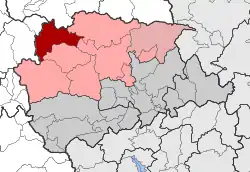Malakasi
Μαλακάσι | |
|---|---|
 Malakasi Location within the regional unit  | |
| Coordinates: 39°48′N 21°20′E / 39.800°N 21.333°E | |
| Country | Greece |
| Administrative region | Thessaly |
| Regional unit | Trikala |
| Municipality | Meteora |
| • Municipal unit | 157.5 km2 (60.8 sq mi) |
| Population (2011)[1] | |
| • Municipal unit | 1,000 |
| • Municipal unit density | 6.3/km2 (16/sq mi) |
| Community | |
| • Population | 138 (2011) |
| Time zone | UTC+2 (EET) |
| • Summer (DST) | UTC+3 (EEST) |
| Vehicle registration | ΤΚ |
Malakasi (Greek: Μαλακάσι) is a village and a former municipality in the Trikala regional unit, Thessaly, Greece. Since the 2011 local government reform it is part of the municipality Meteora, of which it is a municipal unit.[2] The municipal unit has an area of 157.534 km2.[3] Population 1,000 (2011). The seat of the municipality was in Panagia.
Municipal unit
The municipal unit of Malakasi includes the settlements of Korydallos, Malakasi, Panagia, Pefki and Trygona.
Geography
The village is part of the wider Zagori region,[4] between Epirus and Thessaly.
History
The village takes its name from the Malakasii, an Albanian tribe or clan that moved to the area from central Albania in the 14th century.[5][6][7][8] The name most probably refers to the Albanian Malakasii tribe's region of origin in the plain of Mallakastër in southern Albania.[9]
Ottoman period
During the Ottoman period, Epirus and Aetolia-Acarnania were divided into five armatolikia: Malakasi, Tzoumerka, Xeromero, Lidorikion, and Venetiko.[10][11]
In May 1871, Malakasi was the seat of the Malakasi nahiye of the Ioannina kaza.[12]
Demographics
The village is inhabited by "Vlachs" (Βλαχι),[13] who are called Malakasi and inhabit the villages from Malakasi to Gardiki.[14]
References
- 1 2 "Απογραφή Πληθυσμού - Κατοικιών 2011. ΜΟΝΙΜΟΣ Πληθυσμός" (in Greek). Hellenic Statistical Authority.
- ↑ "ΦΕΚ A 87/2010, Kallikratis reform law text" (in Greek). Government Gazette.
- ↑ "Population & housing census 2001 (incl. area and average elevation)" (PDF) (in Greek). National Statistical Service of Greece. Archived from the original (PDF) on 2015-09-21.
- ↑ Dionysios A. Zakythēnos (1976). The Making of Modern Greece: From Byzantium to Independence. Rowman and Littlefield. ISBN 978-0-87471-796-9.
- ↑ Nicholas Geoffrey Lemprière Hammond (1976). Migrations and invasions in Greece and adjacent areas. Noyes Press. pp. 39–42. ISBN 978-0-8155-5047-1.
- ↑ Valentini 1956, p. 306.
- ↑ Sansaridou-Hendrickx 2017, p. 289.
- ↑ Fine 1994, p. 253.
- ↑ Valentini 1956, p. 306
- ↑ Apostolos Euangelou Vakalopoulos (1976). The Greek Nation, 1453-1669: The Cultural and Economic Background of Modern Greek Society. Rutgers University Press. ISBN 978-0-8135-0810-8.
- ↑ Миодраг Стојановић (1984). Хајдуци и клефти у народном песништву. Српска академија наука и уметности, Балканолошки институт. p. 41.
- ↑ Константин Леонтьев; Анатолий Васильевич Торкунов (2003). Дипломатические донесения, письма, записки, отчеты 1865-1872. РОССПЭН. p. 319. ISBN 9785824303766.
- ↑ Tom Winnifrith (1987). The Vlachs: the history of a Balkan people. Duckworth. ISBN 978-0-7156-2135-6.
- ↑ Nicholas Geoffrey Lemprière Hammond (1967). Epirus: the Geography, the Ancient Remains, the History and Topography of Epirus and Adjacent Areas. Clarendon P.
Bibliography
- Fine, John Van Antwerp (1994), The Late Medieval Balkans: A Critical Survey from the Late Twelfth Century to the Ottoman Conquest, University of Michigan Press, ISBN 978-0-472-08260-5
- Sansaridou-Hendrickx, Thekla (2017). "The Albanians in the Chronicle(s) of Ioannina: An Anthropological Approach". Acta Patristica et Byzantina. 21 (2): 287–306. doi:10.1080/10226486.2010.11879131. S2CID 163742869.
- Valentini, Giuseppe (1956). Il diritto delle comunità nella tradizione giuridica albanese; generalità. Vallecchi.